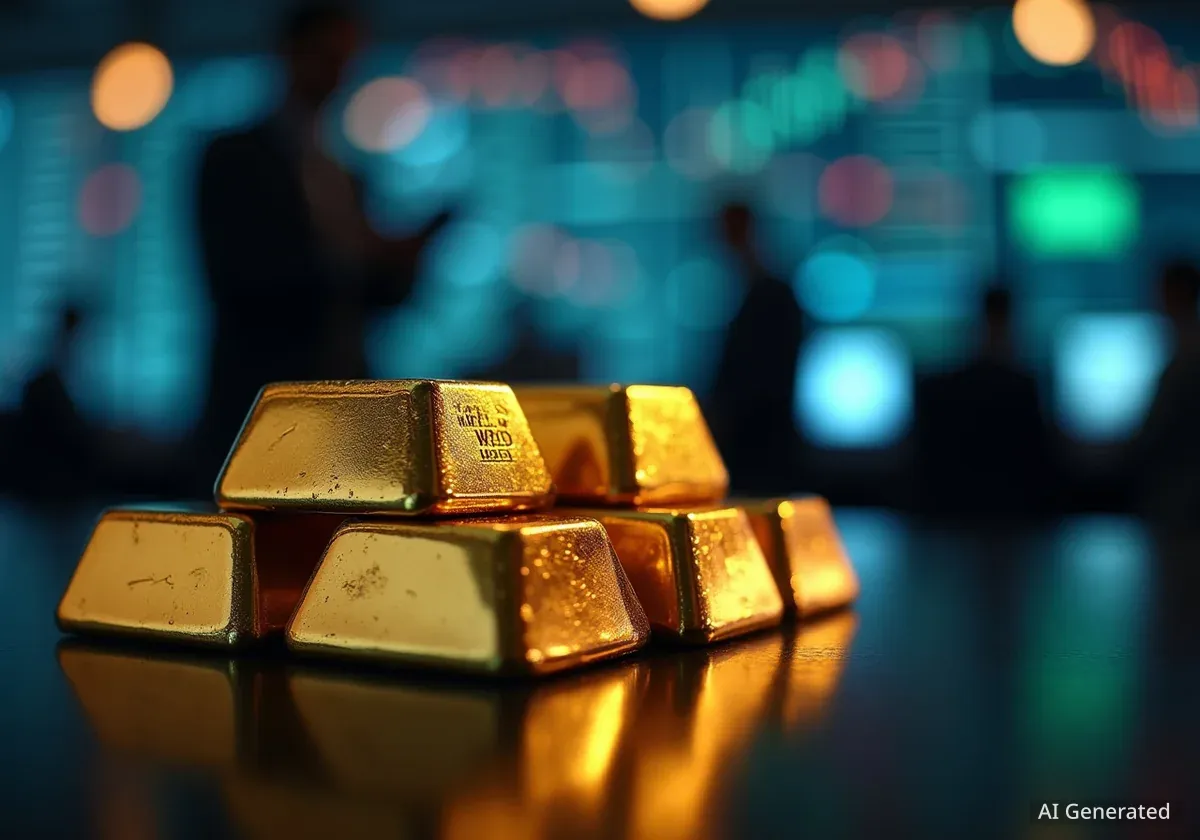Gold prices have surged by over 60% since the beginning of the year, significantly outperforming major stock market indexes and cryptocurrencies. This rally has pushed the precious metal to unprecedented levels, prompting analysts to revise their forecasts upwards as demand remains strong amid global economic shifts.
The rapid increase in gold's value highlights its role as a safe-haven asset, attracting investors concerned about various geopolitical and economic factors. This sustained upward trend has challenged previous predictions, with gold reaching targets much faster than expected.
Key Takeaways
- Gold prices have climbed over 60% this year, surpassing stock and crypto performance.
- Forecasters now project gold could reach $5,000-$6,000 per ounce in the near future.
- Economic uncertainty, stock market volatility, and central bank actions are driving demand.
Gold's Unprecedented Rally Continues
In late March, Goldman Sachs projected gold would hit $3,300 per troy ounce by year-end. However, gold reached this level in less than a month. The metal has continued its ascent, setting new all-time highs almost daily. This rapid appreciation has made it difficult for experts to keep pace with their predictions.
Just last week, Goldman Sachs increased its year-end forecast to $4,900 per ounce, up from an earlier $4,300. This revision came as gold surpassed $4,300 for the first time on Thursday, marking a year-to-date gain of approximately 65%. This represents gold's largest rally in half a century.
Gold's Performance Snapshot
- Year-to-date gain: Approximately 65%
- Goldman Sachs revised forecast: $4,900 per ounce by year-end
- Bank of America projection: Peak at $6,000 per ounce by spring
Factors Driving Gold Demand
Investors often seek precious metals during periods of economic and geopolitical instability. Gold is currently benefiting from several key concerns, including potential U.S. government shutdowns, escalating global trade tensions, and ongoing stock market volatility. These factors collectively create an environment where traditional assets appear less secure.
Given the expectation of continued price increases, some financial experts recommend that investors consider increasing their allocation to gold within their portfolios. This strategy aims to provide a hedge against broader market risks.
"Momentum in gold has been unrelenting," stated LPL in a recent research note. The firm highlighted a 3-to-1 ratio of upside to downside days for gold since late August, indicating strong buying pressure. LPL also noted that the latest surge is underpinned by increasing uncertainty over the U.S. government shutdown and "fear-of-missing-out" flows into physical gold ETFs.
The Debasement Trade and Investor Concerns
A significant driver of gold's surge is the so-called debasement trade. Global investors are increasingly concerned about high levels of government debt. This concern leads them to favor gold and other hard assets over government bonds and investments denominated in the U.S. dollar. This shift reflects a desire to protect wealth from potential currency devaluation.
Economic Context
The current global economic landscape features persistent trade tensions, widespread economic uncertainty, and some analysts believe stocks may be overvalued. In this environment, gold serves as a classic hedge against risk. Its low correlation with equities and bonds, especially during market stress, makes it a valuable diversifier for investment portfolios.
UBS suggests that expectations for continued interest rate cuts by the Federal Reserve, even with inflation remaining above its 2% target, could further weaken the U.S. dollar. This scenario would likely boost investment flows into bullion, making gold an even more attractive asset.
Central Bank and Retail Interest
Amid a weaker dollar, more global central banks have turned to gold to diversify their reserves. Central bank purchases increased significantly following Russia's invasion of Ukraine in 2022. Goldman Sachs notes that both ETF purchases and central bank demand are "sticky" components in their pricing framework for gold, suggesting sustained institutional interest.
Retail demand for physical gold has also contributed to the price rally. Owning gold bars and jewelry holds deep cultural significance, particularly in India and other parts of Asia. Many buyers in these regions have accelerated their purchases as prices continue to climb, driven by both cultural tradition and investment motives.
- UBS forecast: Global gold demand expected to reach 4,850 metric tons this year.
- This level would be the highest since 2011.
- Purchases from the Perth Mint, a key supplier for Asian buyers, rose 21% in September compared to August.
Potential Risks and Future Outlook
While the gold rally shows strong momentum, any rapid asset appreciation carries inherent risks. The World Gold Council, while acknowledging gold's "strategic foundation remains robust," has outlined short-term scenarios that could lead some investors to realize their profits.
For example, a resolution to the U.S. government shutdown or a de-escalation of other geopolitical tensions could cause gold investors to shift their focus to other assets. Additionally, the year's rapid price increase might temper future retail demand, and portfolio allocations to gold could reach a point requiring rebalancing towards other investment vehicles.
Investors should carefully consider these potential shifts when evaluating their gold holdings and future investment strategies. The market remains dynamic, and while current trends favor gold, external factors could influence its trajectory.





